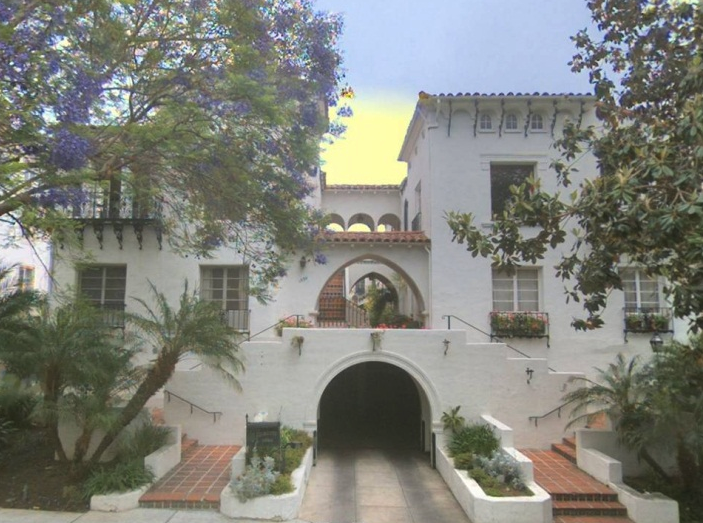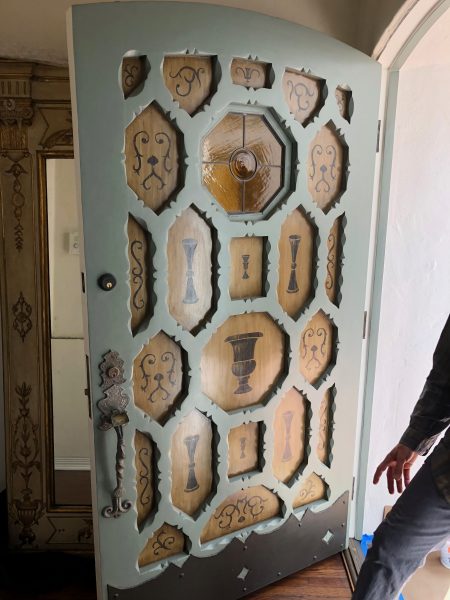
He’s the man who perhaps is best known in West Hollywood for his alleged threat to tear down the El Mirador, the Spanish Colonial Revival building on the northeast corner of Fountain and Sweetzer avenues. And then there’s his loss of a lawsuit against the City of Santa Monica in 1984 that inspired Jim Ellis, a Republican legislator from San Diego, to push through legislation that allowed a landlord to evict tenants if he wanted to stop renting to them.
But there’s more to Jerome Nash, a man with a passion for restoring and preserving the historic properties that he owns, a man inadvertently tied to the Ellis Act when, at the age of 18, he was trying to figure out what to do with a building given him by his mother.
Nash’s deeper history and his passion for preservation aren’t widely known. In fact, he’s somewhat averse to publicity – you won’t find photos of him on Facebook or Instagram or through a Google search. Much of Nash’s story has been heavily distorted in coverage by the now-defunct WeHoNews.com of his plans for the nearby El Mirador building.

Nash’s real story emerged in bits and pieces during an hour-long conversation on a recent tour that he gave of El Pasadero, the Spanish Colonial Revival building at 1330 Harper Ave. Built in 1931, the 15-unit building fell into disrepair under the ownership of Sandra Carradine. Nash took it over and found himself in a vicious fight with two tenants. In May 2013, he invoked the Ellis Act and began a renovation to convert El Pasadero into an urban inn.
The result is a building in which virtually every detail of the original design by Jason and Irene Reese has been restored, with modern amenities such as washers and dryers and closed circuit television discretely added.
The renovation has taken nearly five years. In part that’s because Nash had to deal with the death of his brother. But largely it is because of the incredible detail of his work in restoring El Pasadero. One example is the mahogany window frames.
“They are mahogany windows from Ireland,” Nash said. “So they are solid mahogany, like that that was there originally. You know how we know? Because we took the window sills there were there originally and we scraped them” to identify the type of wood.
“When you do a historical renovation before you do anything, you see what you have,” Nash said. “You don’t just demo it.”
There are countless other examples of detailed restoration. For example, the door handles to each of the 15 units are original. Some of the tiles that replace some of the old floorings aren’t original, but they are manufactured so as to look like the original ones. Delicate illustrations at the top of the walls in some units also are perfectly replicated. Nash also had restored what he calls “broken bottle” windows, which are made with pieces of glass that provide a ripple effect.
“I’m not trying to brag,” Nash said as he pointed out the restoration. “This isn’t my work. I’m just a custodian.”
Indeed, Nash is the custodian, or, to put it more accurately, a trust established by him is the custodian.

“I get the pleasure of taking care of them in my lifetime,” Nash said of El Pasadero and the dozen other buildings he owns here and in New York. “… Then I’ll have the trust that will maintain them afterward. (The buildings are) owned by a revocable trust that is part of a larger trust that will fund them in perpetuity.”
His passion for preservation is one reason Nash won’t convert the El Pasadero into condos, as some have rumored. “I would never make these condos,” he said. “These are to preserve the future. With condominiums, you have 14 owners who want to fight, and change the colors.”
So if not a condominium, then what? It was May 7, 2013, a little more than five years ago, when Nash notified tenants of El Pasadero that he was invoking the Ellis Act to evict them from the building. Under state and city law, Nash could begin re-renting apartments in the building five years after the eviction at market rental rates.
But Nash instead decided to make the building an “urban inn” along the lines of the Charlie, cluster of English-style cottages on Sweetzer Avenue once occupied by Charlie Chaplin, but with some major differences. One difference is the length of stay. Nash doesn’t want a flood of one-night stays. “It’s not going to be an Airbnb,” he said.
One reason for that is his desire to ensure the preservation of the restoration that he has spent hundreds of thousands of dollars on. Nash also wants to reduce the likelihood of damage to the expensive art and furnishings in each of the units. Much of that art comes from a collection that Nash once housed in the 9,000-square-foot townhouse that he owned on East 71st Street in Manhattan. The furniture comes from a variety of places and, depending on the unit, might be very Mid-Century Modernist or much more traditional.
And what about El Mirador, the seven-story, 32-unit apartment building erected in 1929 on Fountain at Sweetzer? Nash and the City of West Hollywood were engaged in a fierce battle in 2012 over the future of that building. The battle ended with the City Council voting to allow Nash to convert the empty apartment building into a condo building or an urban inn if he paid more than $900,000 in fees and reduced the number of units to 28. Nash rejected that offer, and the word spread that he intended to demolish the building all the way to the ground.

However, the building still stands, and Nash has begun some work on restoring it, work delayed in part by his focus on El Pasadero and the death of his brother. El Mirador has sat empty for eight years, and Nash says “it’s a financial joke.” Still, he says, “it needs to be preserved.”
El Mirador also is an asset of the trust Nash has established to keep and preserve his historic properties. He says there is no way he will make it a hotel. He has received the city’s permission to turn it into a condominium, but for the same reasons cited for not doing that with El Pasadero, Nash says no.
What else might surprise those who see Jerome Nash as the cantankerous developer who fights with City Hall for the right to destroy historic buildings and as the force behind the Ellis Act?
Well, for one thing, Nash actually likes most of the folks he has dealt with at City Hall. He especially called out his good relationship with City Attorney Mike Jenkins. The others he praises include former Community Development Director Stephanie DeWolfe and former Development Director Anne MacIntosh and John Keho, interim director of planning and development services, and Cynthia Zabala, the acting building official with planning and development services.
And for another, he’s not an ardent supporter of the Ellis Act and resents that he’s been attached to it.
“I’m not the Ellis Act,” Nash said. “Do what you want if you want to vote it out. I didn’t vote it in … I was 18 years old. My court case was supported by a wealthy landlord. I just wanted to get an entitlement for a small project in Santa Monica.
“They (the supporters of the Ellis Act) didn’t even talk to me (before introducing it in the state legislature). I wasn’t involved with it.”
Nash says he has been asked to make speeches on the Ellis Act and has declined. “I say, ‘Why? I might as well do speeches on the dodo bird’.
“And honestly, if they want to get rid of the Ellis Act, there’s a Yiddish word, ‘zie gezunt.’ No problem. Honestly.”
It only takes an hour with Nash to make it clear that when discussing the Ellis Act he interprets “zie gezunt” as “yeah, whatever,” rather than the more traditional “be healthy.” After all, his focus is on preservation.
Other images of the restoration of El Pasadero are on the pages below:

Here’s a deeper dive into Jerome Nash from the LAT, focusing on how he got his start by suing his mother. “The judge also said Jerome, 31, had “acted like an absolute barbarian, a renegade, a jerk.” The judicial rebuke came after Jerome reputedly had “verbally abused,” “threatened” and “cursed” a secretary, a receptionist and his brother, David, at an earlier settlement conference.” https://www.latimes.com/archives/la-xpm-1992-04-26-vw-1120-story.html
Here’s a deeper dive, I worked for Jerome Nash in 2013. Dale was the manager of the El Mirador. He is an “absolute barbarian, a renegade, a JERK” and VERBALLY abusive, threatened and cursed! YES! That is him. Oh by the way, he does pay a lot of his vendors and employees! I never got my last pay check from him. I could’ve won 3 times my pay hands down in court! You have to pay your employees. He was so abusive I couldn’t stand the thought of going to court against him.
I keep looking at exquisitely beautiful old Spanish architecture like this & grieving that they are no longer built. West Hollywood is becoming a city of glass boxes with no eye appeal whatsoever. They don’t make ’em like this anymore but they certainly could
The notion that one is entitled to an apartment in perpetuity is insane. Honestly. I’m for affordable housing and for restoration. You can have both – just perhaps not in the same space in this case.
So, how much did Nash pay Wehoville for this flowery, glowing review of him? I think the people whom were displaced by his use of the Ellis Act and his general behavior would disagree with the whole “passion for restoration” trope. He sunk a lot of money into his first property remodel not to make a building available for residents of West Hollywood but to create a little space where he could brag about how much money he spent to wealthy guests who care not about what happens to WeHo and it’s apartment buildings but would rather hear the tales… Read more »
I really, really wanted to like this story. But for some reason, I can’t figure it out, it just left me feeling indifferent…….Maybe I’m just hungry.
Artifice is rarely satisfying.
There are apparently many sides to Jerome Nash and this is the one he apparently wants the public to see now…..sort of a PR burnishing. The aluminum window issue sure did a quick turnaround into mahogany windows from Ireland! On the face of it the work appears to be preservation minded but one thing is for sure, Jerome Nash is no Richard Jenrette, collector of magnificent homes with his Classic American Homes Preservation Trust. Jenrette, who recently passed away, was a true gentleman and lover of historic properties as well as a consummate businessman. His 24 Rules for Success would… Read more »
I lived in this building for six years. It has such a special place in my heart. Thank’s for bringing care and attention to such a historic beauty.
It’s a precious thing to restore buildings to their original materials and beauty.
I had never heard – or I forgot – that after five years you could take a building that you removed from the market and put it back on the market for the same purpose and far higher prices.
Repeal the Ellis Act.
As a kite d (35 or so years ago) my mother had a friend living in El Pas. I still remember going with her and how impressive the apartment was. Glad it’s been restored.
My recollection of the El Mirador situation is a bit different. As I recall, the original windows were falling off the building, literally into the street. The Historic Preservation Commission required that they be replaced, like for like, to remain authentic to the building. Nash dug in his heels and was going to replace them with aluminum windows. He dug in his heels further, Ellised out all the tenants and has left the building sort of vacant for about 6 years (it’s common knowledge that the building wasn’t vacant, but whether he was collecting rent or allowing friends to stay… Read more »
The Ellis Act was passed in 1985, named after Republican State Senator (1981-1988) James “Jim” L. Ellis, a former representative of San Diego.
You are going to blame Nash for the law itself, or for taking advantage of it? I think the law needs to be changed, but I’m not going to hold him accountable for it, even if I might have done something different, had I been in his shoes.
It is sad to see such a glorious building having remained vacant for so long.
I believe it was he and his family that worked with Sen. Ellis to get the law passed.
You are correct. I had no idea.
http://www.preservetheellisact.org/history/
Nice to read this, glad he is not the monster WehoNews.com made him out to be. Great story, and glad he has the money and smarts to do what he is doing.